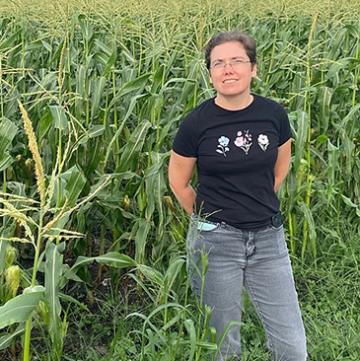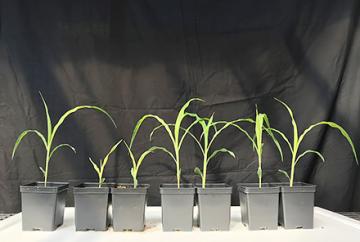A Biochemical Balancing Act

ARS molecular biologist Anna Block stands in a field of corn. (Image courtesy of Anna Block)
Life is full of choices: Save or spend? Sleep or exercise? Fight or flight?
Plants, too, face trade-offs – sometimes with life-or-death consequences. Like all living creatures, plants have limited resources to accomplish key tasks like growing and fighting off enemies. Does pursuing one task interfere with plants’ ability to accomplish others? Not necessarily, according to Anna Block, research molecular biologist at the Center for Medical, Agricultural and Veterinary Entomology, in Gainesville, FL. Her research is shedding light on some of the most fundamental questions about how plants work and balance their metabolic needs – and in doing so, may also help to produce stronger plants, better-equipped to withstand a multitude of stresses.
In looking at the so-called “growth-defense trade-off,” Block said, “There’s been in the scientific community for quite a while the thought that the limited resources plants have available may necessitate the turning on and off of defense compound production.” Specifically, in the case of the defenses that Block studied, corn produces a chemical compound called farnesyl diphosphate, a so-called “precursor compound” that the plant then turns into zealexins, another type of compound that it uses to combat pathogens. The rub, though, is that farnesyl diphosphate is also a precursor compound for other chemicals that corn plants use to grow. So, “there may be negative effects if we increase resistance [to pathogens] by increasing the production of these compounds,” Block said. “There could be decreases in growth and in yield, which obviously is not something that farmers want.” Farnesyl diphosphate used for one purpose – defense – meant less available for growth; or so it seemed.
The story became more complicated when Block and a team of collaborators began to explore how the plants managed the apparent trade-off. Corn has three different genes that encode enzymes that make farnesyl diphosphate; the fact that there are multiple, distinct genes involved suggested to the researchers that there might be differences in the uses of the resulting compound from each enzyme. Using the gene editing CRISPR/Cas9 technology that has become a potent tool of biology, they created mutant plants that lacked one or another of these three genes.
The results confirmed their suspicions: depending on which gene was knocked out, the resulting plant might have very different changes to the way it functioned, exhibiting stunted growth, discoloration, or other irregularities. What was bad for the experimental plants was good for knowledge about them as a group: Block realized that because the use of the precursor compound was controlled, plants were not necessarily facing the trade-off that might be suspected. Allocating more energy or resources to producing farnesyl diphosphate for defense didn’t necessarily mean less for growth, because the plant was making the compound in different ways for those distinct purposes; robbing Peter did not, in this case, increase payment to Paul.

Corn plants display the effects of genetic mutations that affect their development, including growth. (Image courtesy of Anna Block)
The implications of this finding are significant, both for corn and beyond. “If we’re trying to produce crop varieties that have higher levels of these compounds for defense, one of the worries initially was that by pushing it, you might have a negative effect on growth,” said Block. “I think my work shows that for these compounds in particular, that may not really be a big issue, because the metabolic flux has been separated by the plant during evolution, so it gives us the scope to be able to increase these compounds without negatively affecting growth.” The upshot could be corn that is more robust in multiple ways – better at fighting pathogens, but also bigger and better-yielding.
Although Block’s focus is on corn, a staple crop, it may hold promise for other plants as well. “This mechanism of gene duplication and functionalization is probably reasonably widespread for different pathways,” she said. “You could probably take some information from this to other crops such as rice and some of the other grass crops which have similar defense compound pathways.”
That knowledge could prove particularly important as climate stresses increase and corn and other plants face what Block refers to as “combinatorial stress situations,” – the simultaneous challenges of things like flooding, heat waves, and high atmospheric CO2 levels. It might help answer questions, Block said, like, “How does the plant adapt, and how can we help it adapt better to these new stresses?”
Ultimately, Block said, “All the factors always intersect with each other, the stresses, the growth, and the compound production, and how effective they are, so it’s kind of that balance that we’re looking at.” - By Kathryn Markham, ARS Office of Communications

